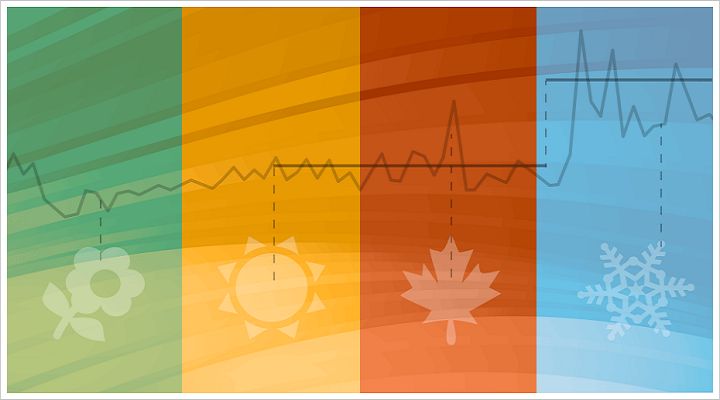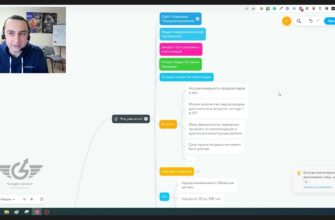- What is seasonality of demand in business?
- Why track seasonal demand?
- What determines the seasonality of demand for goods and services?
- Time of the year
- Holidays and traditions
- Beginning and end of the school year
- Financing of budget programs
- Economic activity
- Sale periods
- Irregular events
- What are the different types of seasonality?
- How to check the seasonality of demand?
- Google Trends
- Keyword Planner
- Key Collector program
- How to use the effect of seasonality on demand?
Buying activity is not stable all year round. Demand is constantly changing depending on the time of year, weather and other factors. This phenomenon is called seasonality of demand, and it has a huge impact on the profit potential of almost any business.
Even if a company produces products that are bought in both summer and winter, the needs and wants of customers still fluctuate throughout the year. For example, ice cream is popular primarily in the heat, and before New Year everyone buys pyrotechnics and presents. And there are plenty of such examples.
According to research by BigCommerce marketers, about 40% of all online sales occur in the last quarter of the year – October through December. Several major holidays and sales occur during this time – Black Friday, Cyber Monday, Christmas and New Year’s Eve. People are more willing to spend money on these days.
How many calls and sales will I get by ordering contextual advertising from you?
I need to calculate the conversion of my website Describe
the task
in the application
Calculate potential ad revenue Google
contextual advertising calculator
Therefore, it is essential for any business to understand exactly how the demand for its products changes throughout the year. This will allow you to optimally plan your marketing budget, adjust your advertising strategies and even your communication with customers.
What is seasonality of demand in business?
Seasonality of demand is the fluctuation in sales caused by different temporal phenomena within a single year. It has a significant impact on most modern businesses. This influence is especially strong for online stores and retailers.
At the same time, seasonality should not be confused with cyclical fluctuations in demand. Thus, seasonality is always associated with plus or minus the same periods within a calendar year, while cyclical fluctuations can occur at any time and can last even more than a year.
Seasonality can manifest itself in specific months, seasons, individual weeks or even days. It is influenced by many factors, including economic and political events, force majeure, weather conditions and fashion trends.
Companies that can anticipate and adapt to these changes have a significant advantage. They can optimize purchasing and inventory management, avoiding overstocking or shortages, and develop effective marketing campaigns.
Ignoring seasonality, on the other hand, can lead to serious financial losses. A vivid example is a confectionery shop producing a large batch of cakes in mid-July, which does not take into account the abundance of fresh fruit and berries on the market during this period. As a result, the demand for cakes drops significantly and they have to sell them at cost price, missing out on potential profits.
Why track seasonal demand?
Understanding seasonal fluctuations in consumer demand helps you make more informed decisions when planning demand and sales. For example:
- By knowing when a surge in consumer activity is expected, companies can increase production in advance and build up sufficient inventory. This ensures that products are on store shelves and that customers’ needs are met at the most important times.
- Companies can more accurately plan purchases and avoid producing or ordering unnecessary products before an expected drop in demand. This reduces the risk of not realizing some of their inventory balances and thus freezing working capital.
- Instead of purchasing goods at inflated prices during peak periods, companies can buy products in advance when prices are lower. This increases profitability and frees up financial resources for other business tasks.
- Transportation and delivery problems often arise during holidays and large-scale events. Knowing this in advance can help adjust delivery schedules and routes, utilize alternative carriers and ensure priority shipments are received on time.
- Advertisers can tailor advertising campaigns, promotions and content to the specific season and create offers that are as relevant as possible to the needs and interests of the target audience at that time. This increases customer response, drives sales and strengthens brand loyalty.
What determines the seasonality of demand for goods and services?
Seasonality of demand in business is influenced by many factors. It can be related to both natural phenomena and social, economic and cultural aspects of society. Here are the main points affecting consumer activity during the year.
Time of the year
Changes in weather conditions have a significant impact on consumer preferences and purchasing activity in various product categories. Thus, in winter there is an increased interest in warm clothing, heating equipment, Christmas trees and decorations for them. And the conditional demand for swimsuits, shorts, bicycles and other things for active summer vacation is at a minimum level.
With the onset of spring and summer, the situation changes dramatically – sales of sunglasses, beachwear and gardening equipment grow rapidly, while skis, skates and winter equipment remain unclaimed.
The impact of the time of year is not limited to the retail sector. In the construction industry, activity declines sharply in winter due to unfavorable weather conditions, while in spring and summer, on the contrary, there is a significant increase because of the optimal time for work. Similar trends can be seen in all industries where activity is directly dependent on the time of year.
Seasonal preferences of consumers are manifested even in the real estate market. The demand for country houses and dachas traditionally peaks in the summer months (from June to August).
Holidays and traditions
They form stable consumer habits and cause spikes in purchasing activity at certain times of the year. A prime example is the wedding season, which traditionally falls in late spring, summer and early fall. At this time, the demand for the services of caterers, photographers, makeup artists, stylists, as well as for wedding dresses and accessories increases significantly.
Interesting fact! Even choosing a specific wedding date can affect the prices and availability of services – many couples tend to book “beautiful” dates with repeating numbers (e.g. 08.08.08), which further enhances the effect.
National and religious holidays also have a powerful impact. In the run-up to New Year’s Eve, consumers purchase gifts, Christmas decorations and products for the holiday table. On the eve of March 8, florists and cosmetics stores record an explosive growth in sales of flowers and gift sets.
In some regions, specific holidays are of particular importance – for example, before Easter, demand for confectionery and baking ingredients increases significantly.
Seasonality of demand is also shaped by social attitudes and trends. Familiar aspirations to “lose weight by summer” or “start the new year with a clean slate” lead to a surge of interest in gyms, healthy food and fitness products.
At the same time, the impact of holidays and traditions on the seasonality of demand for services and products can vary by region and target audience. For example, on Halloween Eve in some countries there is an increased demand for pumpkins and themed costumes, while in other regions this holiday does not have a significant impact.
But major holidays, such as New Year’s Eve or Christmas, cause a surge in consumer activity in almost all product categories. People not only buy gifts, but also update their closet more often, buy household appliances and electronics, and attend entertainment events.
Beginning and end of the school year
On the threshold of September 1, the need for school uniforms, stationery, colors for teachers sharply increases. Families actively purchase new furniture and equipment to equip their child’s workplace, choose additional classes and sections for them.
But some companies, for example, photo studios, on the contrary, receive increased profits at the end of the school year, providing services for the organization of graduation. In turn, copy centers record a surge in demand for printing graduation albums and diplomas.
How many calls and sales will I get by ordering contextual advertising from you?
I need to calculate the conversion of my website Describe
the task
in the application
Calculate potential ad revenue Google
contextual advertising calculator
Financing of budget programs
In public enterprises and private businesses, at the end of a certain period there is often a need to utilize the budgets allocated for the purchase of various products, which leads to an increase in sales of the relevant goods. At the beginning of the next period, on the contrary, demand falls, because budgets have not yet been allocated.
Economic activity
After the holiday spending, many consumers tend to save money at the beginning of the year, which reduces the total number of purchases. In January-February, for the same reason, as well as because of long weekends and holidays, the demand for real estate traditionally decreases. The fact that from late December to mid-January banks and real estate agencies are often closed, and developers become active only by spring plays its role.
Economic seasonality can also be traced in agriculture. During the harvest period, the cost of fruits and vegetables decreases due to their abundance, while in winter prices increase due to the need for storage and imports.
Sale periods
Black Friday or Cyber Monday sale periods have a separate and significant impact on seasonal demand. On these days, companies offering favorable and attractive purchase terms can increase their profits several times due to increased consumer interest in discounts and special offers.
Irregular events
The Olympics, soccer championships, and major cyber sports competitions cause a surge of interest in the respective disciplines and famous players. At this time, manufacturers of sportswear and equipment, sports sections, streaming services, and even video hosting services get their share from the excitement surrounding these events. Companies from related industries (for example, clothing brands with team symbols) can also successfully capitalize on the increased attention of the audience.
What are the different types of seasonality?
As a rule, there are three main types of seasonality depending on the intensity of sales fluctuations:
- Moderate. It is characterized by insignificant changes in demand during the year, with an amplitude of no more than 10-20%. It is typical for everyday products – household goods, household chemicals, as well as for some categories of furniture and bed linen. Despite the presence of periods of increased interest, the overall level of sales remains quite stable, and the business can do without additional incentives. Regular promotion on a routine basis is usually sufficient to maintain steady sales.
- Pronounced. Inherent in products, demand for which in the low season may drop by 30-50% compared to the peak season. Classic examples are summer (swimwear, sunglasses) and winter (skis, snowboards) products. To compensate for falling sales, it is necessary to apply additional incentives – discounts, promotions, loyalty programs.
- Hard. An extreme form of seasonality in which products are in high demand only in very short periods of time, and the rest of the time sales may drop by 50-100%. School albums, plant seeds and New Year gifts are vivid examples of products with severe seasonality. In the off-season, trade in these products may cease completely, and attempts to stimulate demand often prove pointless. It is important for businesses dealing with such products to make the most of the short peak periods to generate the bulk of their annual profits.
How to check the seasonality of demand?
In order to determine the strategy for promoting the site, it is necessary to analyze the seasonal demand for services and goods. There are several services that help to accurately check the seasonality of demand. Each of them has its own peculiarities.
Google Trends
Even a non-professional can easily use this service. Quite simple to understand, the indicators accurately indicate all seasonal changes in the demand for goods for potential customers.
Google Trends shows the data in the form of a clear graph, in which the lower point is the minimum demand, and the upper point is the maximum.
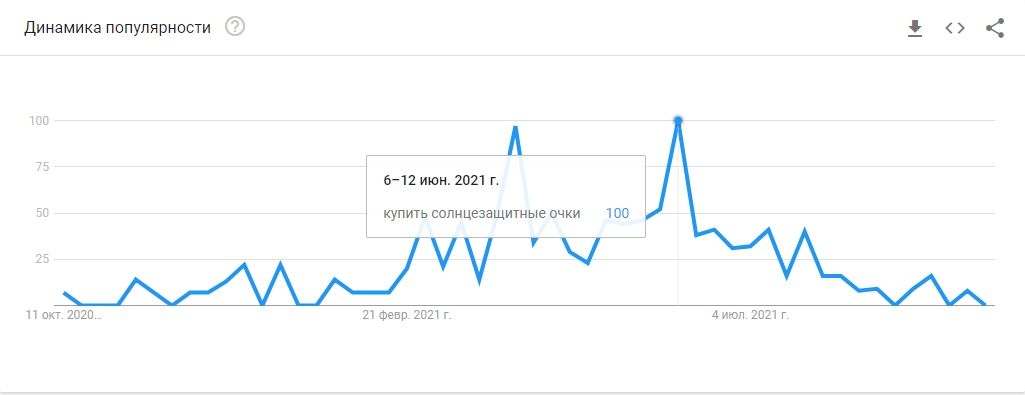
The main distinguishing feature of the service is the ability to track up to five requests, taking into account regional and territorial location. In addition, the service shows statistics on queries for 16 years.
Keyword Planner
Keyword Planner service has a functionality that allows you to track statistics on search queries of interest to you in exact geographical coordinates (you can track the correlation of demand for a particular area, administrative center or city).
To get started, you need to enter the advertising cabinet and specify “Tools and settings”:

Data on requests are available for the period that is selected manually. The maximum period should not exceed 4 years.
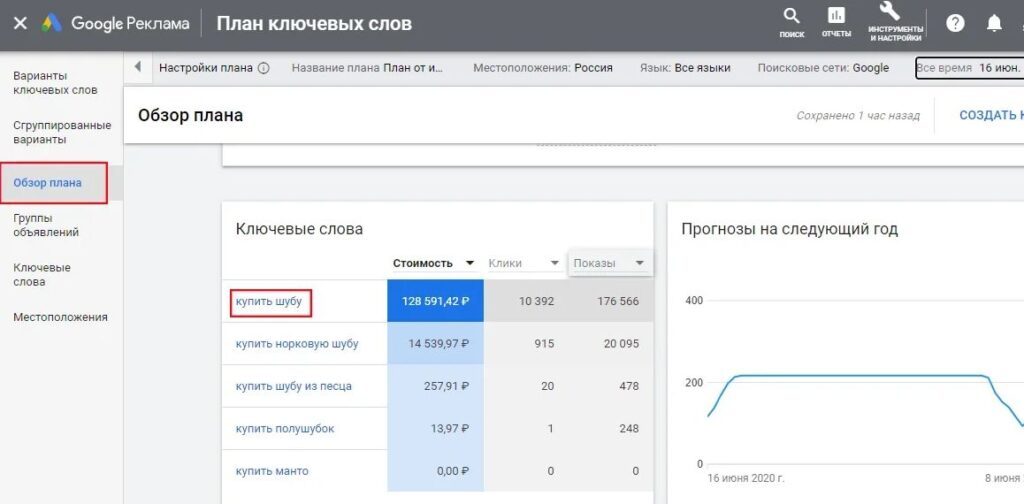
Key Collector program
Using a common service for semantic design you can also track seasonal trends for the keywords of interest.

Key Collector gives you the opportunity to build a frequency graph for the past periods, and on their basis to make a forecast. To get the extended statistics data, you need to select a query in the table and go to “Additional statistics” on the panel at the bottom of the screen:
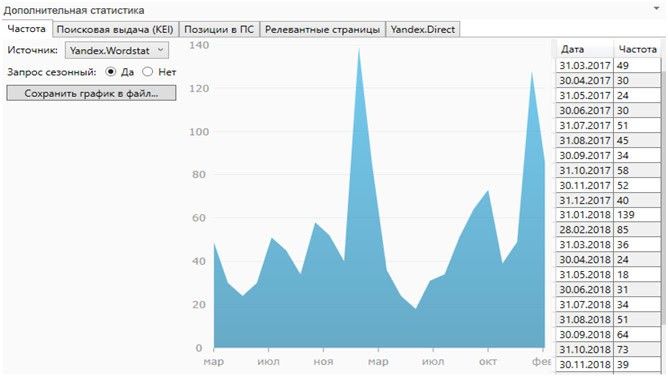
How to use the effect of seasonality on demand?
In order for a business not to suffer from the impact of seasonality on demand it is necessary to use it for good. To do this it is necessary to:
- Expand the offered assortment. If your products are designed only for a certain season, try to expand your assortment and offer consumers goods for which demand does not depend on seasonality. If you have a sporting goods store and your main focus is selling alpine skis and skates, you should add products for summer sports – swimwear, balls and so on;
- Expand the CA. To do this, you can either expand your assortment with related products similar to the one you are selling, or attract the audience with offers in a more expensive or cheaper price segment;
- Engage with customers. It is very important not just to analyze and know your target audience, but to constantly interact with them. With this approach, you will be able to offer a customer a discount on their birthday or anniversary. It will also be easier to send the buyer a favorable offer even before the start of the season. If the goods will still be needed after a certain time – you can buy them in advance at a favorable price;
- Discounts and promotions. Customized bonuses and special offers can motivate a customer to buy even out of season. This motivates customers to keep track of your offers and wait for a sale at any time. In this case, you can even sell fur coats in summer or swimsuits in winter.
Tip! If you use all of the above manipulations, you can not only keep the business and increase profits regardless of the season, but also win the loyalty of regular customers, who in turn will bring new ones.

